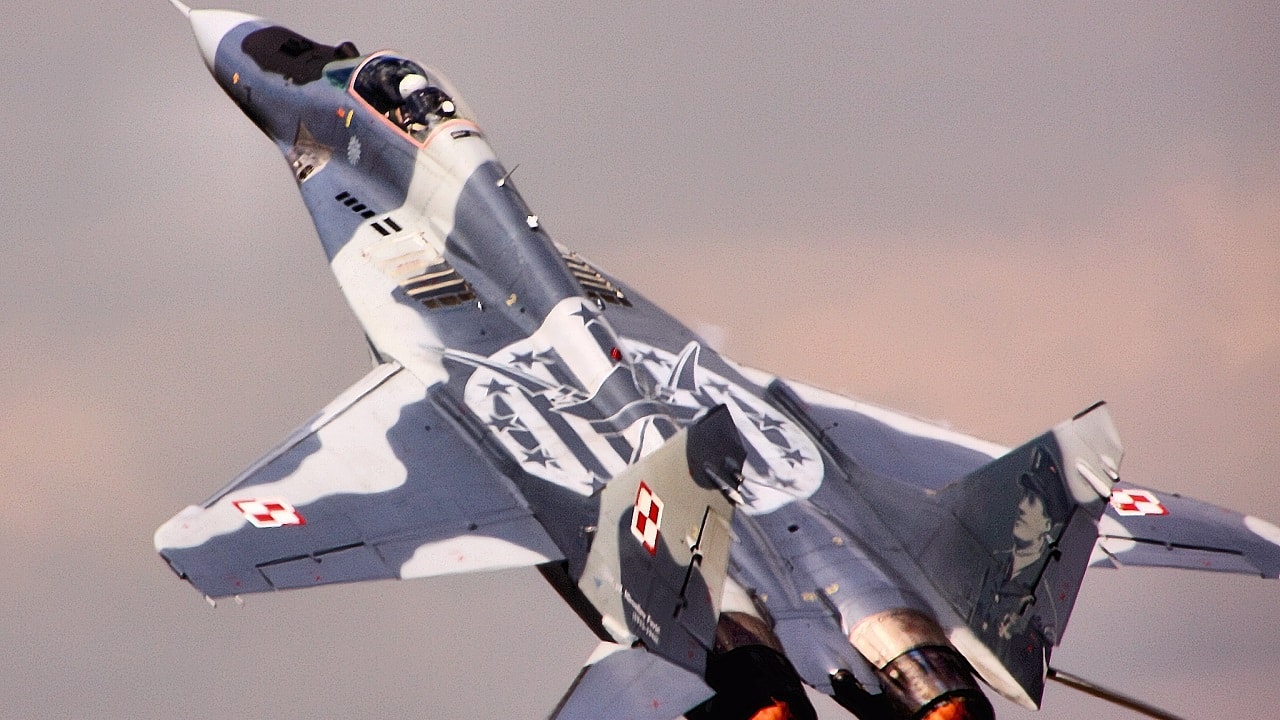Poland’s Air Force: Ready for Russia? Last September, I wrote articles discussing Poland’s army (the Wojska Lądowe) and its navy (Marynarka Wojenna). I detailed their readiness to fight Russia if the need arose.
My conclusion was that while the Poles may lack the sheer numbers to take on Putin’s minions singlehandedly, they certainly are motivated to fight, given their country’s history with Russia. Further, unlike in 1939, Poland would have the backing of NATO.
That said, as a proud U.S. Air Force veteran, it dawned on me that I have yet to give my Polish counterparts their proper due. Let’s correct that oversight today.
Polish Air Force: Brief History, Manpower, and Command Structure
Poland’s air force, the Siły Powietrzne, was officially established in 1918, subsequent to the end of the First World War. Its current manpower is approximately 36,500 personnel, and its total aircraft fleet inventory is estimated at 275.
Poland exercises civilian control over its armed forces, meaning the commander in chief is Poland’s President, Andrzej Duda, with Defense Minister Mariusz Błaszczak next in the chain of command.
The senior ranking air force officer is General of Division Jacek Pszczoła, who holds the official title of inspector of the air force.
Armed Forces General Command is headquartered in the capital city, Warsaw.
From there, the air forces-specific structure consists of two tactical aviation wings, a transport aviation wing, a training aviation wing, a radar brigade, and an air defense missile brigade.
So what fixed-wing combat aircraft do the Poles operate?
Su-22 “Fitter”
This Soviet-designed 1966-vintage warplane is considered a fighter-bomber, but in actual combat, it has proven much better suited for ground attack rather than air-to-air — the Fitter’s performance in the latter arena has been decidedly inauspicious.
The Su-22’s max airspeed is Mach-1.77. Armament consists of two 30mm NR-30 cannon, along with eight to 10 external hardpoints than can be configured with either air-to-air missiles such as the K-13 “Atoll” and R-60 “Aphid,” or air-to-ground missiles such as the Kh-25ML “Karen,” Kh-58E “Kilter,” Kh-25MP “Kegler,” and Kh-29 “Kedge.”
Poland has an estimated 18 Su-22s.
MiG-29 “Fulcrum”
This fourth-generation, Soviet-designed fighter plane made its maiden flight in October 1977. It has received an uptick in press coverage thanks to Putin’s “special military operation” in Ukraine. The Fulcrum is supposed to be the equal of the American-made F-15 Eagle and F-16 Fighting Falcon.
In practice, the MiG-29 has proved unequal to the task, at least in the hands of Iraqi and Serbian pilots who flew them against Western pilots in Operation Desert Storm and Operation Allied Force, respectively.
However, the MiG-29 is still a highly capable warbird in a skilled pilot’s hands, as the Ukrainian air force has repeatedly demonstrated.
With a max airspeed of Mach-2.25, it packs a punch, starting with a single Gryazev-Shipunov GSh-30-1 30mm autocannon, and moving along to a pair of hardpoints with a capacity for 4,000 kilograms-worth of bombs or air-to-air missiles. The Fulcrum is definitely no slouch.
Poetically, Poland has 29 MiG-29s.
F-16 Fighting Falcon/”Viper”
For any readers who may worry that the Polish air force is stuck flying Warsaw Pact equipment, take heart: The addition of the Viper to their roster shows that the gallant Poles are bringing their aerial arsenal up to speed with their NATO partners’.
Poland flies the F-16-C/D Block 52, which first appeared in 1990. This variant features the F100-PW-229 Improved Performance Engine, which is lighter and more powerful than earlier models.
Additionally, these warbirds will be equipped with JHMCS and Sniper ER pods and armed with AIM-9X Sidewinder heat-seeking air-to-air missiles, AIM-120C “Slammer” Advanced Medium Range Air-to-Air Missiles, Joint Standoff Weapons, and Joint Direct Attack Munitions.
By acquiring these planes in 2006 as part of the Poland Peace Sky program, the Poles became the first former Warsaw Pact ally to operate the F-16.
The Siły Powietrzne has 48 Vipers at its disposal.
The Future
Polish planners are not content to stop at the acquisition of fourth-generation fighters. For starters, they’ve ordered 48 of South Korea’s KAI T-50 Golden Eagle, which will be officially designated the FA-50PL in Polish parlance.
These will replace the Su-22 and MiG-29. Meanwhile, in spite of all the horror stories about the F-35 Lightning II, the Poles are still willing to take their chances on Lockheed Martin’s fifth-generation fighter, with 32 of them on order. Hopefully the Siły Powietrzne’s wizards will be able to do like the Israeli air force did — work out the bugs and actually make the planes work properly.
Poland’s air forces appear well equipped to rise to the occasion should Russia seek once again to slake its thirst for conquest.
MORE: B-21 Raider: China Should Fear America’s New Stealth Bomber
MORE: H-20: China Is Building a New Stealth Bomber
MORE: Is Russia’s Su-57 Felon Stealth Fighter a Total Bust?
MORE: Merkova: Israel Has A Super Tank
Christian D. Orr is a former Air Force Security Forces officer, Federal law enforcement officer, and private military contractor (with assignments worked in Iraq, the United Arab Emirates, Kosovo, Japan, Germany, and the Pentagon). Chris holds a B.A. in International Relations from the University of Southern California (USC) and an M.A. in Intelligence Studies (concentration in Terrorism Studies) from American Military University (AMU). He has also been published in The Daily Torch and The Journal of Intelligence and Cyber Security. Last but not least, he is a Companion of the Order of the Naval Order of the United States (NOUS).

